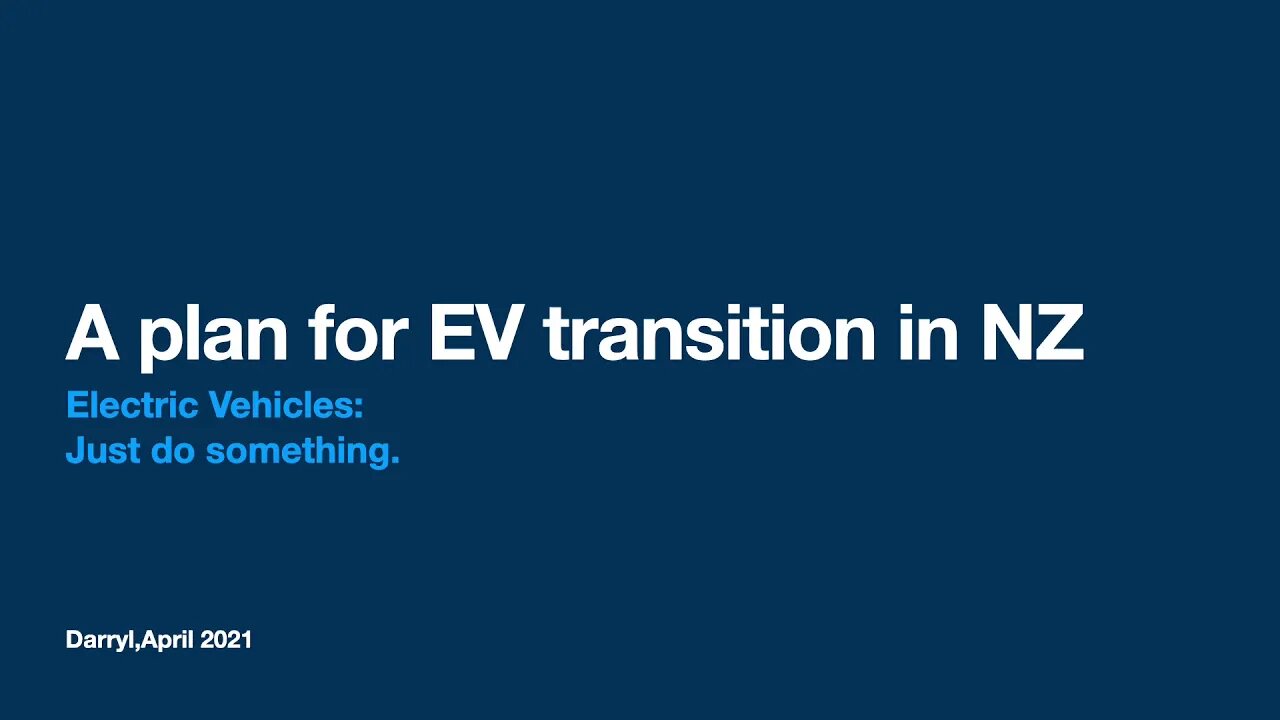Premium Only Content

Alternative to Feebate EV Uptake Plan in New Zealand
New Zealand
3
Many EV chargers and other projects are funded from a contestable fund (EECA)
Non-petrol* vehicles have a tax by weight and distance driven (RUC) road user charges.
Petrol vehicles have RUC charged in the fuel as a tax
Used EVs can be imported
RUC exemption for EVs to expire 2021, may be renewed (*EVs are non-petrol)
People, who have busy lives, know little of EVs
4
The government wanted to get to 64,000 EVs out of about 4,000,000 cars in New Zealand by the end of the year.
They did the stuff on the previous slide
And also confused the market by talking about taxes on new gas guzzlers and rebates on efficient vehicles, but did nothing much (FeeBate scheme)
Reason for doing something: help with emissions, CO2, local pollution, climate change mitigation, inter-governmental goals or something, balance of payments etc.
Lots of talk and posturing, but not too much action, after a good start.
5
Don’t give vehicle companies much in the way of options
The time for debates has passed already
Don’t increase prices of things like useful work vehicles used by people who have important things to do
Don’t harm people and families by charging them extra costs
Give discounts to people doing the right thing, how can that be cost neutral?
6
EVs are defined as vehicles that can drive 180km on a single charge at 90km/h and 150km at 110km/h on flat highways and can rapid charge 100km of driving range in 20 minutes or better. (Equivalent of a 2016 30kWh Leaf or 2018 Hyundai Ioniq)
PHEV, Plug in Hybrid Electric Vehicles are defined as vehicles that can drive 70km on a single charge in EV mode, and have DC fast charging for 50km in 20 minutes, and AC charging for 50km in three hours. (2015 BMW i3 REX, Japan Prius Prime 2018.)
All of this is for new cars. Used cars can just be ignored by the scheme. A new car, can be car that has less than 1000km on the odometer. This is for normal light vehicles, less than 3,500kg, cars, vans, pick up trucks, minivans, sports cars, SUVs etc.
Vehicles need to be fitted with: A type-1 charge connector or a type-2 charge connector.
Vehicles also need to be fitted with a CHAdeMO rapid charge connector or a CCS (type-2) rapid charge connector.
7
There will be EV sales goals for companies that sell new cars. The calculations can done per year, over the brand of cars sold, per single car sales yard, or over a group of car yards under common ownership, if they sell multiple brands, or yards in many towns or suburbs.
Every car yard location in the scheme, with 10 cars for sale, must have at least two EV vehicles for sale on the yard.
There will be punishments, fines, for companies that don’t make the EV sales goals.
Car companies can import vehicles that are not their main brand, to make up their numbers, if they don’t have many EVs for their main brand. But they have to sell them on the yards with their main brand. They can rebrand a vehicle if they want.
Tiny special car companies or brands, that sell fewer than 100 vehicles per year in New Zealand, and don’t sell any EVs globally, can be initially exempt. But if a company pools a bunch of specialist cars, like sports car marques and brands, and sells more than 100 vehicles, they have to sell the required balance of EVs.
8
Vehicle brands that sell only EVs don’t have to participate in the scheme.
Vehicle companies cannot buy, acquire or trade unused vehicle credits from another company. Selling EVs between car yards don’t count as sales.
The EVs and PHEVs sold have to be at least as good as the minimum specifications on the previous page to count.
A car company that sells more than their required EV percentage, may sell some small EVs that don’t meet the minimum requirements.
Companies not making the sales figure, get fined the average non-EV sales price per car, for their company, multiplied by the percentage they missed out by.
9
Let’s call the first year of the scheme 2022, it can be calendar year, but financial year, tax year is probably better.
In 2022, all new car sales companies need to sell 5% EVs (they can be Pure EVs or PHEVs as defined earlier). In 2022, the minimum range requirements are exempt, but the charging port requirements need to be met.
In 2023, the sales required are 10%, but this year the range requirements are required. If sales exceed 10% the range requirements are not required on the vehicles over the 10% line
10
As you can see, car companies will be motivated to find and sell EVs. They can import and sell vehicles that are not their primary brand, the vehicles just have to meet the specifications required for charging connectors, charger performance and driving range.
In 2024, 15% of vehicle sales with be EVs (and PHEVs). Also minimum EV range is changed to 250km, and PHEV range to 120km.
In 2025 there is a 10% step change to 25%.
In 2026, 35% sales will be EVs. minimum EV range to 300km.
Then add 10% per year up to 95%
The RUC exemption ends in 2021.
-
 LIVE
LIVE
LFA TV
2 hours agoLFA TV ALL DAY STREAM - WEDNESDAY 9/3/25
7,162 watching -
 1:23:53
1:23:53
JULIE GREEN MINISTRIES
2 hours agoLIVE WITH JULIE
78.2K107 -
 18:23
18:23
Producer Michael
20 hours agoWHAT REALLY HAPPENED IN DUBAI!
50.3K5 -
 6:32
6:32
Blackstone Griddles
14 hours agoCajun Smashburgers with Bruce Mitchell | Blackstone Griddles
17.5K9 -
 43:16
43:16
The Finance Hub
18 hours ago $2.83 earnedBREAKING: DONALD TRUMP JUST SHOCKED THE WORLD!
23.6K12 -
 2:00:57
2:00:57
BEK TV
1 day agoTrent Loos in the Morning - 9/03/2025
9.44K -
 LIVE
LIVE
The Bubba Army
23 hours agoNick Hogan Sues Bubba to BLOCK the DOC - Bubba the Love Sponge® Show | 9/03/25
1,746 watching -
 8:01
8:01
MattMorseTV
14 hours ago $11.87 earnedHe's ACTUALLY doing it...
82.5K84 -
 33:25
33:25
Uncommon Sense In Current Times
17 hours ago $3.66 earnedHollywood’s Woke Agenda Exposed | Kevin Sorbo on Cancel Culture, Faith & the Common Sense Revolution
42.3K3 -
 8:23
8:23
The Art of Improvement
22 hours ago $2.09 earned7 Smart Habits to Boost Mental Clarity
22.4K4